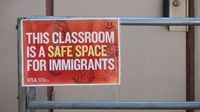As the new academic year unfolds across the United States, a sweeping crackdown on undocumented immigration under President Donald Trump’s second term is sending shockwaves through communities and institutions nationwide. From the streets of Los Angeles to the classrooms of Chicago, the impact of aggressive enforcement tactics, new deportation agreements, and the struggle for transparency is reverberating in ways both seen and unseen.
According to reporting by ABC News and other major outlets, the Trump administration’s latest push to fulfill its campaign promise of the largest mass deportation in U.S. history has introduced a climate of fear and uncertainty for millions of immigrant families. Masked agents have been spotted detaining individuals at work sites and in public spaces, while the Department of Homeland Security (DHS) has largely stopped publishing comprehensive statistics on removals and deportations. Instead, only partial data on detentions is released, often inconsistently and without much explanation, as noted by Berkeleyside.
In the face of this opacity, a group of data scientists and lawyers at UC Berkeley’s School of Law launched the Deportation Data Project in March 2025. Led by assistant professor David Hausman, the project is now the only reliable source of detailed Immigration and Customs Enforcement (ICE) data since the administration’s clampdown on information. Funded by an anonymous donor, the project compiles available statistics, submits monthly Freedom of Information Act (FOIA) requests, and, when necessary, files lawsuits to force the release of data. “We sued because ICE had not responded to our request at all; a lawsuit was the only way to get the data in any reasonably timely way,” Hausman explained to Berkeleyside.
The project’s findings have been cited in hundreds of news stories, including those by The New York Times, CNN, and The Los Angeles Times. Among the most striking revelations: since January 2025, arrests nationwide have more than doubled, but most migrants deported this year have no criminal conviction. In Los Angeles, the majority of those arrested had no criminal record at all. As arrests climb, non-criminals are increasingly caught up in the system—a fact that runs counter to the administration’s claim that only the “worst of the worst” are being targeted.
For journalists like Kelly Waldron at Mission Local, the Deportation Data Project has been transformative. Waldron and her colleague, Frankie Solinsky Duryea, used datasets on ICE arrests, detentions, and deportations to track the journeys of individuals from arrest to detention and eventual deportation, even though the data is anonymized. “This data helped us stitch together the journeys of people arrested in our local jurisdictions. It was an incredible help and I don’t know how we would have gotten this information otherwise,” Waldron told Berkeleyside.
But the story extends beyond statistics. As children returned to school for the 2025-2026 year, immigrant families across the country expressed deep anxiety. ABC News reports that in Los Angeles and Chicago—two of the largest public school systems—districts have implemented new protections for immigrant families. Chicago Public Schools, for example, now prohibits ICE agents from entering facilities without a criminal warrant signed by a federal judge. In Los Angeles, over half a million students returned to schools where the district police force is working with local law enforcement to ensure safe spaces “regardless of immigration status,” according to Superintendent Alberto Carvalho.
The fear is palpable. Esmeralda Alday, former executive director of dual language and English as a second language migrant education for the San Antonio Independent School District, described how some families—especially those of mixed status, where the children are U.S. citizens but the parents are undocumented—have unenrolled their children due to perceived threats from ICE and actual detention orders received by mail. “It’s coming at our families from every angle,” Alday told ABC News. “It’s affecting our families from all angles, almost leaving them with no choice but to self deport.”
Viridiana Carrizales, co-founder of ImmSchools, echoed these concerns, stating, “They don’t want our kids. They don’t want immigrant kids in schools, they don’t want them to get educated and that’s what’s happening. We have parents who are not taking their kids to school, we have parents who are withdrawing their kids from programs that are critical for their children.” Carrizales worries that the lack of support for these students will ultimately harm everyone in the community.
Despite these fears, DHS Assistant Secretary Tricia McLaughlin told ABC News that no arrests have been made on K-12 school grounds during Trump’s second term as of August 19, 2025. She asserted that the majority of arrests have targeted individuals with prior criminal convictions or pending charges and reassured that “no K-12 students who are U.S. citizens should fear deportation or ICE raids, even if their parents are undocumented.” Yet, the administration did lift restrictions that previously kept ICE from conducting raids on sensitive sites like schools, churches, and hospitals. McLaughlin defended the move, saying, “Why would you want a criminal to take safe harbor in a hospital or house of worship or a school?”
The fear has had measurable consequences. In Texas, student absenteeism spiked during the last school year and summer learning sessions. In Los Angeles, attendance issues persist, with families navigating virtual learning options to avoid physical visits to schools. Board member Tanya Ortiz Franklin told ABC News that families are struggling with the decision of whether to attend school events or prioritize their safety: “It’s permeating brown communities, in particular, [and] our Black immigrant communities, our Asian immigrant communities, of which there are many in Los Angeles.”
On the international front, the Trump administration has struck a series of controversial deportation deals as part of its broader crackdown. As reported by the BBC and CBS, on August 20, 2025, the U.S. reached bilateral agreements with Honduras and Uganda to accept deported migrants, including those who are not their own citizens. Uganda agreed to take an unspecified number of African and Asian migrants who had claimed asylum at the U.S.-Mexico border, provided they have no criminal history. Honduras will receive several hundred deported people from Spanish-speaking countries over two years, with the possibility of accepting more.
These deals are part of a wider push: at least a dozen nations—including Paraguay, Rwanda, Panama, and Costa Rica—have agreed to accept deported migrants from the U.S. Rwanda, for instance, will take up to 250 migrants, but reserves the right to approve each individual. Human rights campaigners and UN experts have condemned these policies, warning of the risks migrants face if sent to countries where they could be harmed. The U.S. Supreme Court recently cleared the way for Trump to resume deportations to third countries without allowing migrants to contest the risks, a decision that drew sharp dissent from several justices.
As the administration’s efforts to accelerate deportations continue, the work of the Deportation Data Project and the voices of affected families and advocates are shaping the public conversation. Transparency, accountability, and the human cost of policy decisions remain at the heart of the debate—one that is far from settled as the nation grapples with the consequences of its choices.






